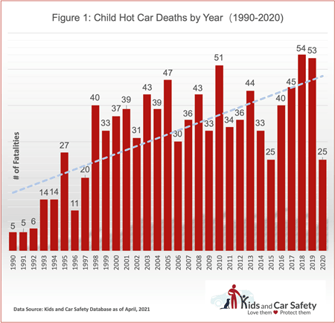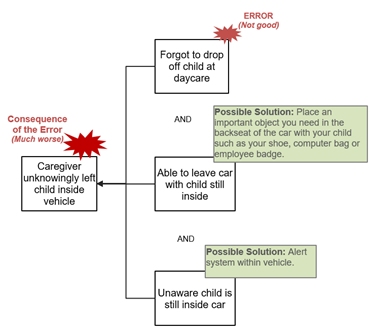In an effort to bring attention to a significant risk that demands our awareness: the tragic instances when young children are unintentionally left alone in sweltering vehicles, leading to fatal consequences. Startling statistics KidsandCars.org, reveal that, between 1990 and 2020, an average of 39 children lose their lives each year in the United States due to hot car incidents. In fact, 2018 and 2019, were the worst years with 54 and 53 reported deaths, respectively. The number of deaths went down in 2020 to 25 fatalities, but this is likely attributed to COVID-19-related restrictions, closed childcare facilities and reduced travel.

As we move into the summer months, it’s important that we understand how and why parents and caregivers too often forget children in the backseat so we can prevent it from occurring in the future. In this blog, we delve into the crucial subject of preventing these unimaginable tragedies. Using Cause Mapping® root cause analysis we shed light on the pivotal role human error plays in these devastating events and emphasize the necessity of addressing this factor to effectively mitigate the associated risks.
In fact, one of the first errors that a caregiver can make is to ignore the risk due to the false perception that this could “never happen to me.” Psychologists refer to this as optimism bias, and, unfortunately, it causes us to underestimate risk. A critical risk that we must account for is that our memory is fallible, in spite of our best intentions and regardless of the severity of the outcome.
When we forget or lose focus during an important task, there are multiple causes that align to produce the outcome. Revealing this system of causes provides opportunities to control those causes and prevent occurrence. In fact, when analyzing problems that involve “human error,” it is common for investigators to focus solely on the human condition and summarize the incident as “inattention,” “complacency” or the self-evident “human error.” These generic explanations result in generic, ineffective solutions, such as “be more careful” or “pay more attention,” and in some cases, even disciplinary action.
Work Process Reliability™
Preventing these types of errors requires moving past the human condition and revealing the other factors that affect Work Process Reliability™. Work Process Reliability focuses on five human factors that affect the results you get within a process or task. People perform tasks using equipment and materials within an environment. Variability within these factors can lead to an unplanned outcome like forgetting to pick up a loaf of bread at the grocery store or forgetting to drop your child off at daycare. While the implications of the examples are nowhere close to comparison, the causes that combine together to produce the outcome are often very similar. By understanding the causes, solutions can be identified to mitigate the risk—in spite of our fallible nature.
The Cause Map™ diagram provides an analysis of the most common scenario of hot car deaths, which is when a child is unintentionally left in a vehicle. In many of these cases, the caregiver forgets to drop off the child at a planned destination and, out of habit, proceeds along their typical route to work or another routine destination. As the Cause Map diagram illustrates, the incident requires multiple causes combining to produce the unimaginable.
For example, another cause often cited is exhaustion or fatigue. It’s well known that parents of newborns up to 2 years of age suffer from sleep deprivation. This can compound over the course of the workweek and affect human performance. Add this to other stresses at work commanding our attention or other unique unexpected variables, and you have just created the “perfect storm.” In this disastrous scenario, the parent or caregiver is going through the motions driving to work, tired, focused on the stresses of the job, while forgetting that today was the one, unique day that they were supposed to drop off the child at daycare. Nearly every caregiver that has experienced this tragedy didn’t think it could ever happen to them.
Layers Of Protection
In addition to revealing the causes related to human error, another important opportunity is to reveal causes that contribute to the consequence of the error. Mitigating the consequence of an error is an important feature of highly reliable organizations (HROs) and reveals opportunities to add layers of protection. For example, on the Cause Map diagram, there are three causes required for the child to be left inside the car: the child was left in the vehicle because the caregiver forgot to drop of the child at daycare AND they are unaware the child is still inside the car AND they are able to leave the car with the child still inside.

Identifying a solution that controls ANY ONE of those three causes prevents the fatality. For example, some vehicle manufacturers, including Hyundai and Ford, have begun including an automatic reminder in their new model vehicles to remind drivers to check the backseat. Or another creative solution is to change your process for driving, so you always place an item you wouldn’t get far without, like a shoe or your work badge, in your back seat with the child. This reveals significant leverage from a process reliability standpoint. We can significantly increase the reliability of the task in spite of human error.
Finally, even if you leave the child in the car, are there opportunities to incorporate backup reminders as another layer of protection? For example, if the childcare provider is expecting your child, instruct them to call immediately if the child doesn’t arrive on time. You can learn more about other potential solutions and further understand how to help prevent these incidents at kidsandcars.org.
Training Opportunity
If you are interested in learning more about how to analyze human error and incorporating concepts around Work Process Reliability into your problem-solving investigation, I would encourage you to attend the upcoming two-hour online short course. For more information and registration information visit us at training.thinkreliability.com/catalog.












